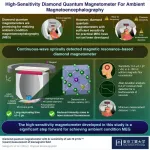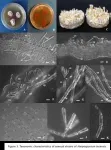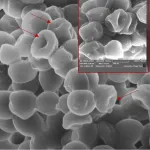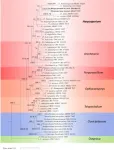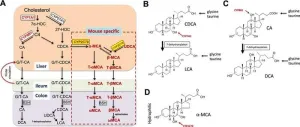Novel diamond quantum magnetometer for ambient condition magnetoencephalography
Researchers have developed a highly sensitive diamond quantum magnetometer that can achieve practical ambient condition magnetoencephalography
2024-06-06
(Press-News.org)
Magnetoencephalography (MEG) is a biomedical imaging technique used for mapping brain activity by recording magnetic fields produced by the naturally occurring electrical currents generated by neurons in the brain, using very sensitive magnetometers. Currently, MEG requires a magnetically shielded room for operation. Achieving MEG that works in normal environments, without the need for magnetic shielding, is a major goal. This would enable daily diagnosis, brain-machine interfaces, and fundamental research on brain function.
Magnetometers using diamond quantum sensors with nitrogen–vacancy (NV) centers are promising candidates for realizing ambient condition MEG. These sensors are expected to offer significantly better millimeter-scale resolution than conventional centimeter-scale MEGs. Notably, NV centers are defects in the structure of a diamond, consisting of a nitrogen atom substituted for a carbon atom, next to a vacancy. One common method for measuring magnetic fields with NV centers is continuous-wave optically detected magnetic resonance (CW-ODMR). In this method, a continuous microwave field is used to manipulate the spin states of the NV centers while they are illuminated by a laser. The intensity of this laser-induced fluorescence changes depending on the external magnetic field. By measuring these changes in fluorescence, the external magnetic field can be detected and measured. Compared with other methods, this method is simpler and easier and can achieve millimeter-scale resolution.
Building upon this technology, a team of researchers from Japan, led by Associate Professor Naota Sekiguchi from the Department of Electrical and Electronic Engineering at Tokyo Institute of Technology, recently developed a novel and sensitive diamond quantum magnetometer. “Clinically acceptable MEG requires sensitivities, at least, in the order of picotesla (pT) in the near-dc frequency range of 5–100 Hz within a reasonable measurement time. Currently, diamond magnetometers require a magnetic flux concentrator (MFC) to achieve this sensitivity. However, MFCs reduce the intrinsic spatial resolution of magnetometers. Additionally, for MEGs, a short measurement distance is required as the decay of magnetic fields increases exponentially with distance. To overcome these challenges, we designed a sensitive CW-ODMR-based diamond magnetometer,” explains Sekiguchi in detail. Their study has been published in the journal Physical Review Applied.
The novel magnetometer uses a single crystalline diamond which was fabricated using a high-pressure high temperature (HPHT) method. After HPHT synthesis, a piece of crystal was cut out parallel to the (111) crystal plane, and negatively charged NV centers were produced in the crystal using electron beam irradiation followed by annealing at 1000 0C. This NV center ensemble was placed in the sensor head, designed to approach the target to about one millimeter with a sensing volume of 4 x 10-3 mm3. The ensemble was excited by a linearly polarized green laser with a wavelength of 532 nanometers, and a high refractive index hemispherical lens was used to enhance the collection efficiency of the laser-induced fluorescence.
By carefully tuning the experimental conditions, the researchers achieved a record sensitivity of 9.4 ± 0.1 pT Hz-1/2 in the frequency range of 5 to 100 Hz, without an MFC. Additionally, analysis of Allan deviation showed that the magnetometer can measure magnetic fields as low as 0.3 pT and maintain remarkable sensitivity for a long time. Furthermore, its design is suitable for practical applications such as for MEG of a living animal.
The high sensitivities achieved in this study mark a significant step toward realizing ambient condition MEG with millimeter-scale resolution. Looking ahead, Sekiguchi concludes, “In the future, we plan to measure the MEG of animals using the sensors developed in this study and to realize MEG measurements with diamond quantum sensors. Ultimately, we aim to achieve MEG without the need for magnetic shielding.”
END
ELSE PRESS RELEASES FROM THIS DATE:
2024-06-06
A novel antibacterial lipopeptide produced by the bacterium Serratia marcescens has been shown to be highly effective in killing Staphylococcus aureus – one of the most important pathogens occurring in humans.
Staphylococcus aureus is one of the five most common causes of hospital-acquired infections and is often the cause of life-threatening infections following surgery. Since the introduction of antibiotics in the early 1940s, S. aureus has by now developed resistance against most classes of antibiotics, ...
2024-06-06
The genus of Harposporium belongs to the Ascomycota of the Fungi kingdom, the class Sortariomycetes, the order Hypocreales, and the family Ophiocordyceiaceae, is a common genus of soil fungi. The species of Harposporium are pathogens of nematodes, with some also infecting rotifers or tardigrades, and has significant ecological value. In recent years, studies have shown that a few species of the genus Harposporium can also parasitize insects or other invertebrates, such as H. janus, which can infect beetles in the Coleoptera family. However, so far, it has not been found that the same species in this genus can parasitize different invertebrates in both sexual and asexual stages. Is there a ...
2024-06-06
Bile acids are essential molecules the liver produces that play a critical role in digestion. They help us absorb fat-soluble vitamins and cholesterol from our food. However, bile acids can become a double-edged sword. While they are necessary for proper digestion, high concentrations can also be toxic to the liver.
Recent research is shedding light on the complex relationship between bile acids and liver health. Scientists have identified new ways in which bile acids interact with cellular stress responses, impacting how the liver functions in diseases ...
2024-06-06
June 6, 2024, Cleveland: Cleveland Clinic researchers found higher amounts of the sugar alcohol xylitol are associated with increased risk of cardiovascular events like heart attack and stroke.
The team, led by Stanley Hazen, M.D., Ph.D., confirmed the association in a large-scale patient analysis, preclinical research models and a clinical intervention study. Findings were published today in the European Heart Journal.
Xylitol is a common sugar substitute used in sugar-free candy, gums, baked ...
2024-06-06
WINSTON-SALEM, N.C. – June 6, 2024 – People with high blood pressure have a higher risk of cognitive impairment, including dementia, but a new study from researchers at Wake Forest University School of Medicine suggests that engaging in vigorous physical activity more than once a week can lower that risk.
The findings appear online today in Alzheimer’s & Dementia: The Journal of the Alzheimer’s Association.
“We know that physical exercise offers many benefits, including lowering blood pressure, improving heart health and potentially delaying cognitive decline,” said Richard Kazibwe, ...
2024-06-06
LEXINGTON, Ky. — Researchers at the University of Kentucky Sanders-Brown Center on Aging are working to develop a pre-symptomatic disease diagnostic tool for Alzheimer’s disease.
“While the need for better treatments is clear, such treatments will not be very meaningful if they are administered after symptoms have onset. By then, Alzheimer’s disease has been ravaging the brain for decades to the point the brain can no longer compensate for the extreme cellular death,” said Mark ...
2024-06-06
Research Highlights:
Women with excess weight at age 14 or 31 may have increased ischemic (clot caused) stroke risk before age 55. The same ischemic stroke risk was not found in men.
Losing excess weight after adolescence may not eliminate the stroke risk.
These findings are according to a study conducted in Finland that followed more than 10,000 people from birth into their 50s.
Researchers suggest health care professionals pay attention to overweight and obesity in young people and work with them to promote healthy eating and physical activity from an early age.
Embargoed ...
2024-06-06
· Major advance for treatment of deadly brain cancer
· Clinical trial launched at Northwestern to test treatment
· Ultrasound microbubbles open blood-brain barrier to admit chemotherapy and immunotherapy cocktail
CHICAGO --- In a major advance for the treatment of the deadly brain cancer glioblastoma, Northwestern Medicine scientists used ultrasound technology to penetrate the blood-brain barrier and provide a small dose of a chemotherapy and immunotherapy drug cocktail. The study found that this treatment ...
2024-06-06
New research led by Lia Siegelman, a physical oceanographer at UC San Diego’s Scripps Institution of Oceanography, shows that the roiling storms at the planet Jupiter’s polar regions are powered by processes known to physicists studying Earth’s oceans and atmosphere. The geophysical commonalities spanning the 452 million miles between the two planets could even help facilitate an improved understanding of those processes on Earth.
Siegelman first made the connection between our planet and the gas giant in 2018 when she noticed a striking similarity between images of Jupiter’s huge cyclones and the ocean turbulence she was studying. ...
2024-06-06
COLUMBUS, Ohio – A searchable database is now ready to help study Alzheimer’s disease.
Neuroscience and biomedical informatics researchers at The Ohio State University Wexner Medical Center and College of Medicine created the comprehensive, user-friendly repository.
The free database – known as ssREAD – is outlined in a manuscript published online in Nature Communications.
Alzheimer’s disease is the most common cause of dementia, accounting for up to 80% of cases. An estimated 6.7 million Americans who are age 65 and older are living with Alzheimer's dementia today, according ...
LAST 30 PRESS RELEASES:
[Press-News.org] Novel diamond quantum magnetometer for ambient condition magnetoencephalography
Researchers have developed a highly sensitive diamond quantum magnetometer that can achieve practical ambient condition magnetoencephalography
